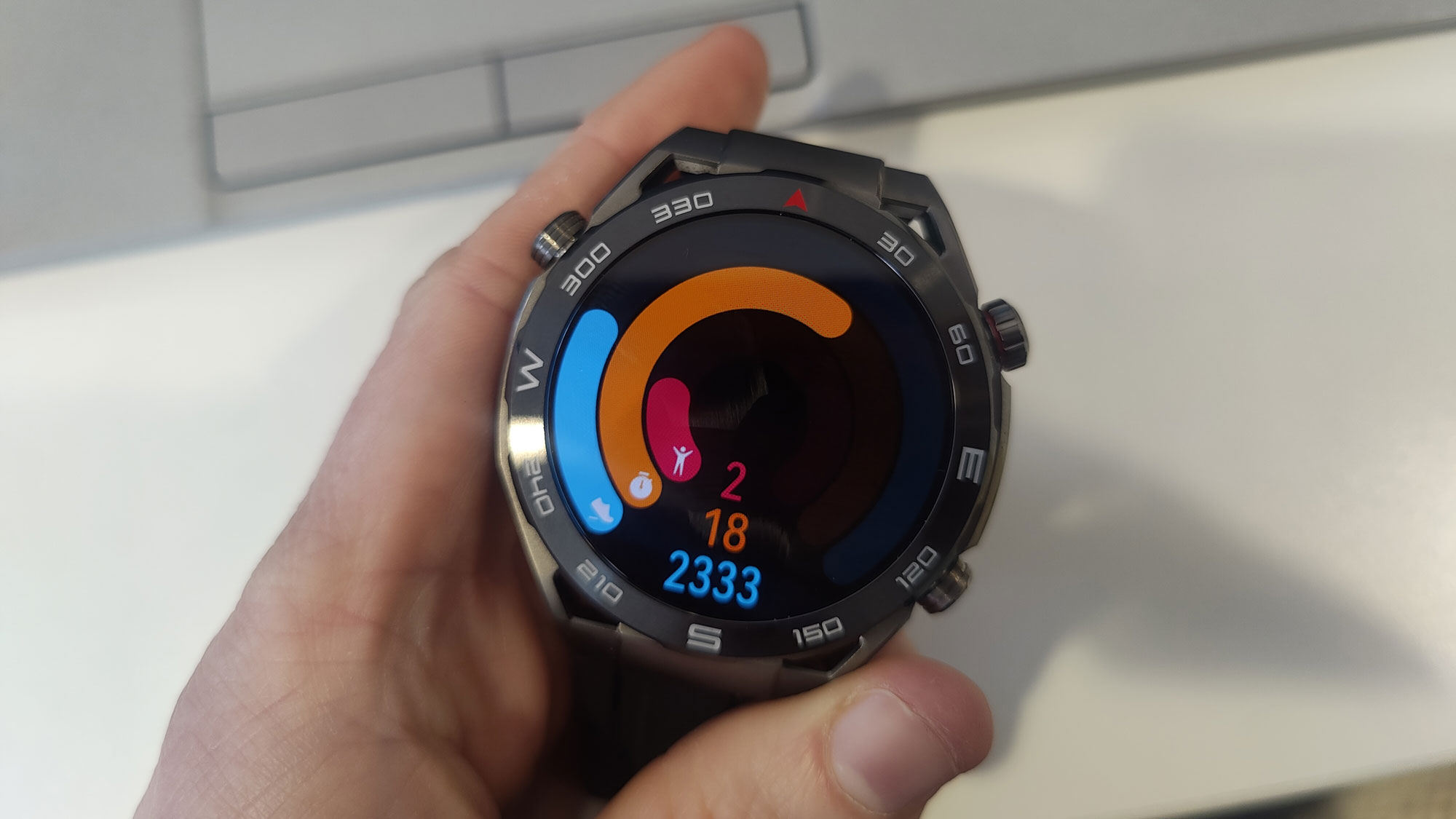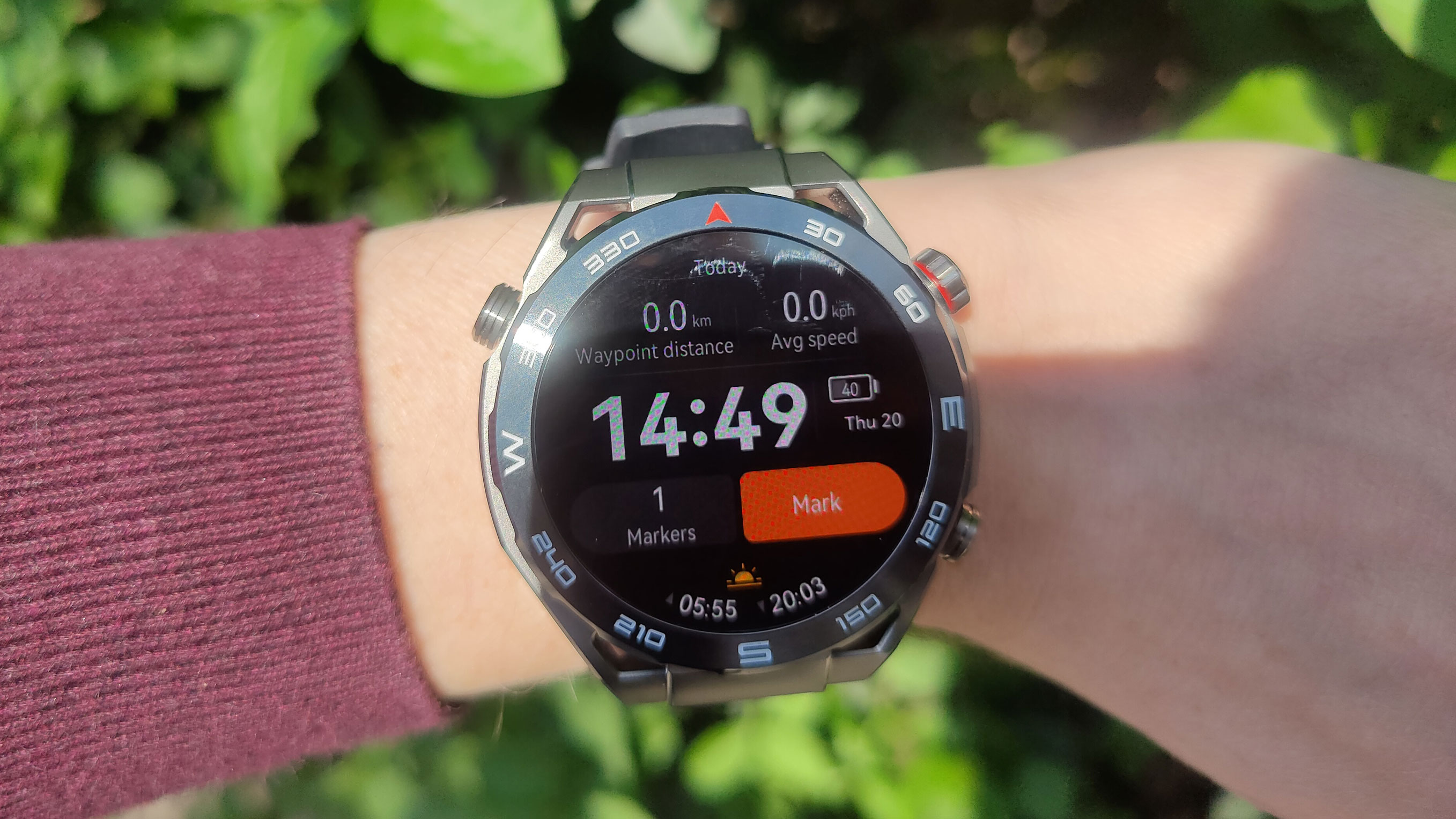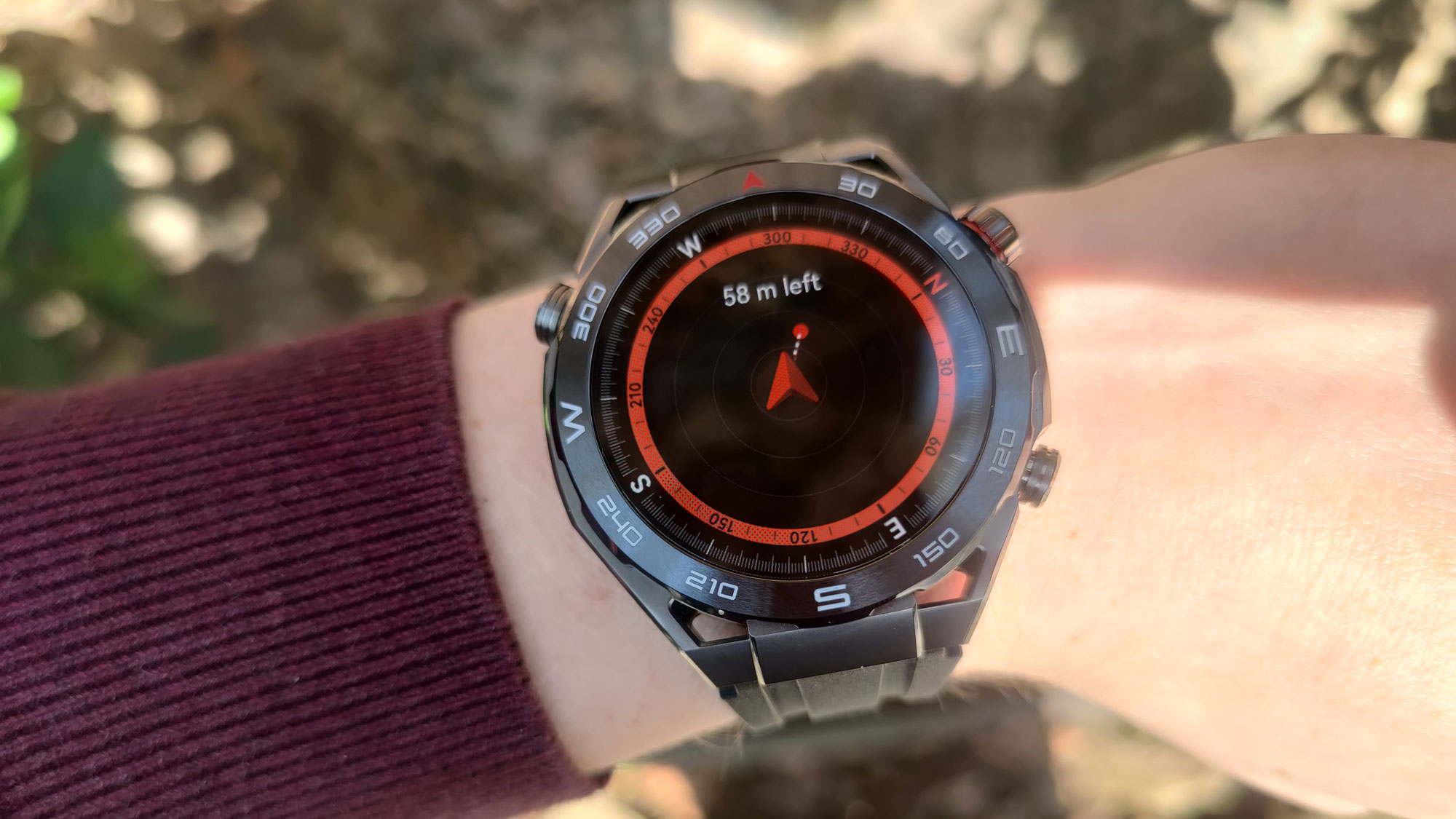Huawei Watch Ultimate: One minute review
This is TechRadar’s Huawei Watch Ultimate review. We’ve gone hands-on with the Apple Watch Ultra rival to test its mettle as a day-to-day smartwatch, a workout device, a health companion, and a tool for outdoor pursuits such as diving and hiking. The end result is a watch that’s designed to go toe-to-toe with the best smartwatches from Apple and the best Garmin watches.
In many ways it succeeds: the physical build quality is nothing short of spectacular, and the watch looks great – with the right watch face. The Expedition mode, designed for outdoor pursuits such as hiking, trail running and orienteering, is a brilliant piece of UX design, and Huawei Health is a great-looking and very functional companion app.
However, the typical and all-too-familiar Huawei frustrations prevent this from beating the top outdoor watches at their own game. There’s no Google Maps or GPX files: instead, the Huawei Watch Ultimate works on Huawei’s own Petal Maps service. There’s also no LTE option, which is frustrating for a watch at this price point, as it means you need to remain coupled to your phone for internet access. Some of the better watch faces cost money from Huawei’s online store. And, without a Huawei phone, there’s no contactless payment option, as it won’t support Google Wallet, Apple Pay or other competing digital wallet services.
I understand Huawei’s instinct to keep things locked down end-to-end in the same way that Apple, Google and Samsung do, but as Huawei devices aren’t as ubiquitous as those of the other brands, it makes recommending the watch more difficult. While the watch will record your running routes using GPS, the omission of on-wrist directions and the inability to stream music without cellular data or a phone nearby are pretty damning. At least it looks nice, it’s tough as nails, and the Expedition mode is ace.
| Component | Value |
| Price | £699 (around $870 / AU$1,300, Expedition Black) |
| Dimensions | 48.5 x 48.5 x 13mm |
| Weight | 76g |
| Case/bezel | Ceramic, zirconium-based liquid metal |
| Display | 466 x 466px, AMOLED sapphire glass |
| GPS? | Dual-band GPS |
| Battery life | 14 days (8 days heavy use) |
| Connection | Bluetooth, NFC |
| Water resistant? | Yes, 10ATm, EN 13319 certified |
Huawei Watch Ultimate: Price and availability
- £699 (Expedition Black)
- £799 (Voyage Blue)
- Unavailable in US, not confirmed for AU
Huawei Watch Ultimate currently starts at £699 (around $870 / AU$1,300) for the Expedition Black version of the watch, which has the standard zirconium liquid metal watch face and casing but a plain black silicone strap. It clearly competes directly with the Apple Watch Ultra at this price, and occupies a similar niche and matches the watch in build quality.
The next level up in price, the Voyage Blue, is designed to look more like a traditional diving watch, something along the line of the Omega Seamaster series. Its segmented deep-blue bezel is complimented by a lighter-coloured case and matching aviation-grade titanium strap, and it costs £799.
Unfortunately, availability is a big part of where this watch falls down: it’s unavailable in the US due to the US government’s ongoing dispute with Huawei. Not having the latest phones with Huawei’s own operating system, EMUI, means that even if you get your hands on the watch, some of its features can’t be used.
Although Huawei technology is currently available in Australia, the Watch Ultimate isn’t yet on sale. It is available in the UK and Europe, and select Asian markets. Is is available in Europe for €749 euros in Expedition Black, and €849 in Voyage Blue.
Huawei Watch Ultimate: Design

- Top-notch build quality
- Big and heavy
- Unimpressive UX
The Huawei Watch Ultimate takes its cues from other premium outdoors watches such as the Garmin Enduro 2 and its principle rival, the Apple Watch Ultra – they’re all big watches with large faces and super-tough cases. The Huawei Watch Ultimate’s case looks great: it’s made of a super-tough, super-hard zirconium ‘liquid metal’ alloy that’s said to be harder than titanium, and finished in a darker grey for the Expedition Black model and shiny silver for the Voyage Blue, which comes with a matching titanium strap.
The Voyage Blue model especially is a thing of beauty, looking for all the world like a smart version of a premium dive watch like a Seamaster. The Expedition Black is a bit more sporty, with its black silicone strap and more demure case, but both still look like fantastic watches – providing you choose the right face. Many of the default options really spoil the look of the watch, and, frankly, make it look cheap: I went through five or six of the ‘free’ watch faces on the AppGallery store before settling on one I actually liked.
Elsewhere the watch is comfortable on the wrist (we tested the Expedition Black model) but it is big and heavy, weighing in at 76 grams – that’s useful when surviving bangs and scrapes, but less so if you’re wearing it to bed, as you might accidentally clobber yourself or your partner with it. By the time my testing period was over and I swapped to my smaller Casio F-91W digital watch, I felt like I’d been weight training. If you’re in the market for a daily wearer, this is a big, heavy, and occasionally inconvenient option.
On the software side, the Huawei Health app is a very good, comprehensively designed companion app, with well-presented data and bags of granular graphs to sink your teeth into, a real treat for health info nerds. I was less impressed with the UX on the Huawei Watch Ultimate: it’s essentially the same layout as on the Huawei GT 4, and if you pinch and zoom, the app layout zooms out into a basic rectangle, with no effort to conform the layout to the screen. It’s a small thing, but very telling, and despite the watch’s beautiful construction, Huawei’s operating system isn’t quite as ergonomic to use as something like watchOS 9.
The similarities with the Huawei Watch GT 4 continue in the physical design, with the exception of the Ultimate mode button on the left-hand side. Pushing this button takes you to Expedition Mode or Dive Mode – I used Expedition Mode most often – with the other buttons acting as controls to select options for individual apps. However, it would be nice if Huawei made the Ultimate Mode button fully programmable, in the same way the Apple Watch Ultra’s action button is.
Huawei Watch Ultimate: Features

- Lots of workout modes
- New Expedition and Dive Modes
- Some features locked away for non-Huawei users
- Lack of LTE is frustrating
Fortunately, the Huawei Watch Ultimate excels at workout tracking, with loads of modes, just like the Huawei Watch GT series before it. Runs are easily and comprehensively tracked –they’re divided into outdoor and indoor runs, with outdoor run tracking rivaling that of Garmin and Polar watches when it comes to the level of granular data you can pull from a run. From Recovery time and aerobic/anaerobic stress to VO2 Max, GPS and Pace Segment information, it’s all here. There’s no heat map of running power laid over your route, as there is on Garmins, which I’ve always found useful, but combined with Expedition Mode this watch is going to be a great trail-running companion.
Speaking of which, Expedition Mode is great. I cover it in more detail in a separate article, but essentially it’s one of two new modes that allow you to see and measure specific vital statistics, use the watch’s torch functionality, set GPS waypoints, and tell you how far away you are from each waypoint. By chaining waypoints together, you can stay orientated, and not have to glance at a GPX map every few minutes.
The Watch also has a heavily-advertised Dive Mode, which we’ve been unable to test yet. Splitting between recreational and free dives in both seawater and fresh water, Huawei says it can operate in and show you accurate depths at up to 100 meters; it can also interface with your air tank to show you readouts on-wrist, and carries a compass for reorienting yourself. I’ve asked a professional diving instructor about the Apple Watch Ultra’s dive credentials, and I’d be fascinated to have the Ultra and the Huawei Watch Ultimate tested alongside each other.
The Watch is stacked with apps and features, from stress readouts and breathing exercises to maps, texting, voice call functionality with the in-built speaker, and Huawei’s AI assistant, which is only available on EMUI phones. Additional third-party apps like Spotify will need to be downloaded via the Huawei AppGallery, which could again be a problem depending on the phone you’re using. Maps uses Huawei’s Petal Maps rather than Google Maps, which is available as a browser download if you can’t get on AppGallery, but it works fine and offers on-wrist directions. Just make sure that you enable permissions on your phone, as without the right permissions okayed, the app will close on-phone and the on-wrist directions will stop.
The most frustrating missing feature here is the lack of LTE or real offline GPS options. If I want streamed music, maps or even the ability to call someone from my watch when I go for a run, I have to take my phone with me. The lack of on-wrist maps or directions independent of my phone is especially egregious for a self-professed outdoors watch – yes, you can set GPS waypoints with Expedition Mode, but you can’t call up a decent map or contact someone if, for example, you twist an ankle. Such omissions are fine for a mid-range watch, but at this price point it’s a real kicker.
Huawei Watch Ultimate: Performance

- Excellent battery life
- Expedition Mode is awesome
- Obnoxious notifications
The Huawei Watch Ultimate’s battery life meets expectations fully. Over two weeks of moderate use, the battery lasted around 11 days – slightly less than the claimed full two weeks – in smartwatch mode, with regular GPS functionality draining the battery. I tested the watch’s GPS against a Garmin Forerunner 265 and the GPS on my Oppo phone during one particular run, and I’m satisfied with the Huawei’s dual-band GPS accuracy, accounting for the time it took to activate and deactivate all three devices before and after running.
The watch’s stand-out feature was the Expedition Mode, which performed better than expected on-wrist. The waypoint finder syncs with the compass to create easy-to-follow directional prompts, and a press of the button switches the readouts to a dim-orange night mode in order to save your eyesight. As long as you remember to drop waypoints to follow regularly enough, your adventures will be unmarred by your getting lost, and the Expedition Mode even has SPO2, barometer and heart rate widgets easily accessible to check your performance at altitude, along with a light for signaling.
One of my biggest gripes with the watch in day-to-day use is the notifications you get during a run, with reminders on how far and fast you’ve run, speeds, and more. On other apps I’ve used, such as Garmin’s or Polar’s, the notifications automatically sync with the headphones you’re wearing. Not so with Huawei – the default, inexplicably, is blasting the bizarrely-accented AI voice at full volume from the watch’s impressively loud speaker. A jog around the park or a workout in the gym can get very embarrassing, very quickly for the uninitiated.
While you can lower the volume, and disable the notifications in the settings, getting the reminders through to the headphones is a frustrating, counterintuitive process. You have to pair the headphones with the watch rather than the phone, which isn’t how it’s done with other services, which means that unless I was playing my own music from my watch, I either didn’t get Spotify, didn’t get the helpful mid-run voice prompts, or had to suffer through the infamous Huawei voice yelling “Workout started!”, “Workout paused!”, “Time: five minutes, fifteen seconds per kilometer!” out to the world.
Otherwise, I was happy: things performed as expected from a premium watch, with all the accuracy and power such a device promises. It’s just a shame that the outstanding build quality and excellent innovations are let down by some frustrating, quintessentially Huawei flaws.
Huawei Watch Ultimate: Should I buy?

| Category | Comment | Score |
| Value | A similar price to the Apple Watch Ultra, this watch looks and feels premium and delivers on its promises, despite some shortcomings. | 4/5 |
| Design | A great-looking, incredibly tough watch with a fantastic companion app, marred by some common Huawei design frustrations. | 3/5 |
| Features | Lots of workout modes, comprehensive sleep tracking, and new outdoor toys like Expedition and Dive modes. No LTE is a big limiter. | 3.5/5 |
| Performance | Excellent battery life that meets expectations, a terrific Expedition Mode and bags of workout options. GPS is accurate, but HUD readouts are a pain. | 4/5 |
| Overall | A good outdoors watch, especially if you’re already a Huawei user, but a few frustrations stop it from being best in class. | 3.5/5 |
Huawei Watch Ultimate: Buy it if…
Huawei Watch Ultimate: Don’t buy it if…
Also consider
| Component | Huawei Watch Ultimate | Apple Watch Ultra | Garmin Enduro 2 |
| Price | £699 (around $870 / AU$1,300, Expedition Black) | $799 / £849 / AU$1229 | $1,099.99 / £929.99 / AU$1,749.00 |
| Dimensions | 48.5 x 48.5 x 13mm | 49 x 44 x 14.4mm | 51 x 51 x 15.6mm |
| Weight | 76g | 61.3g | 70g |
| Case/bezel | Ceramic, zirconium-based liquid metal | Titanium | Fibre-reinforced polymer, titanium |
| Display | 466 x 466px, AMOLED sapphire glass | 410 x 502px, Always-On Retina LTPO OLED display | 280 x 280px, transflective MIP |
| GPS? | Dual-band GPS | L1 and L5 GPS, GLONASS, Galileo, QZSS, and BeiDou | GPS, GLONASS, Galileo, SatIQ |
| Battery life | 14 days (8 days heavy use) | 36 hours | 34 days (110 hours GPS) |
| Connection | Bluetooth, NFC | LTE, Wi-Fi, Bluetooth 5.2 | Bluetooth, Wi-Fi, ANT+ |
| Water resistant? | Yes, 10ATm, EN 13319 certified | Yes, 40m, ISO standard 22810 | Yes, 10ATM |
First reviewed: April 2023




